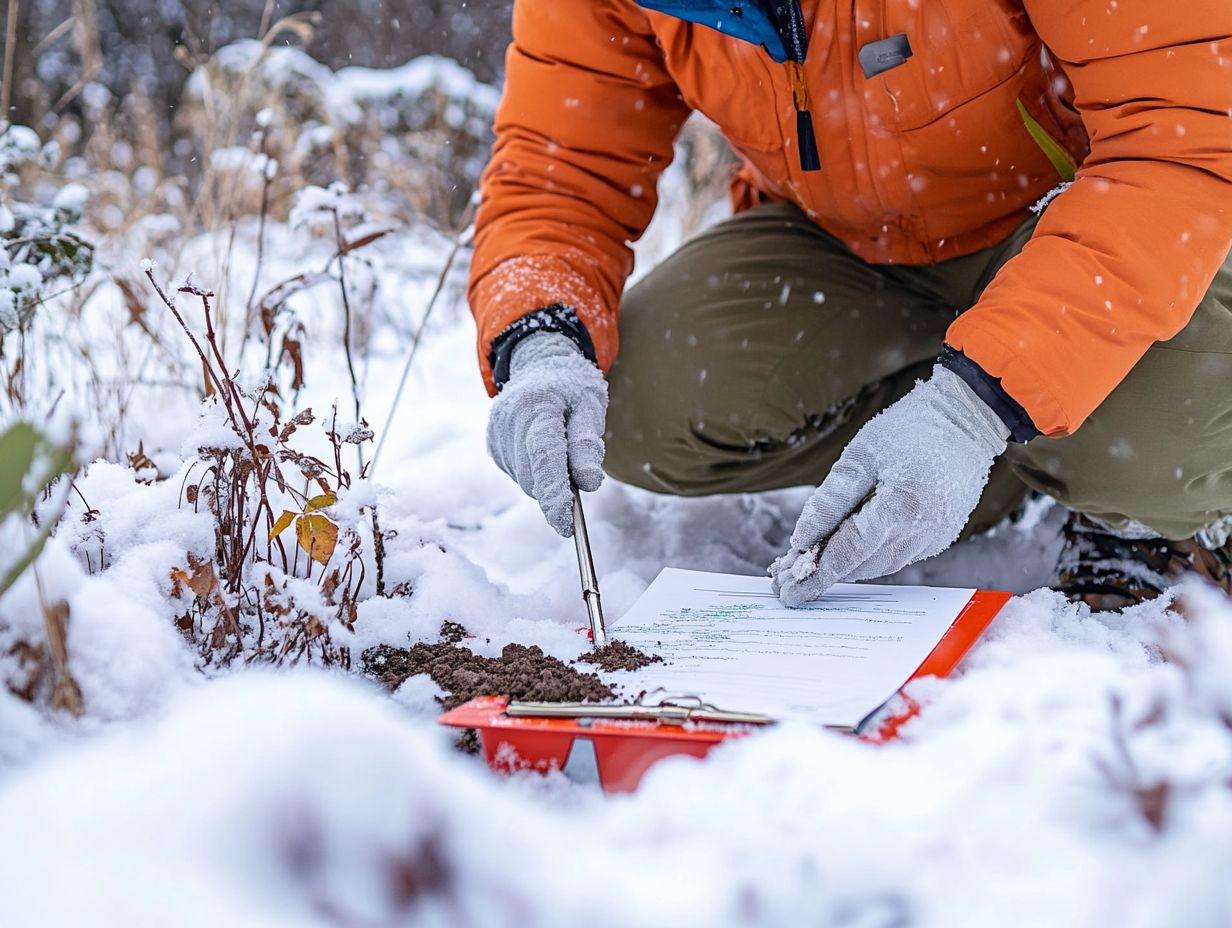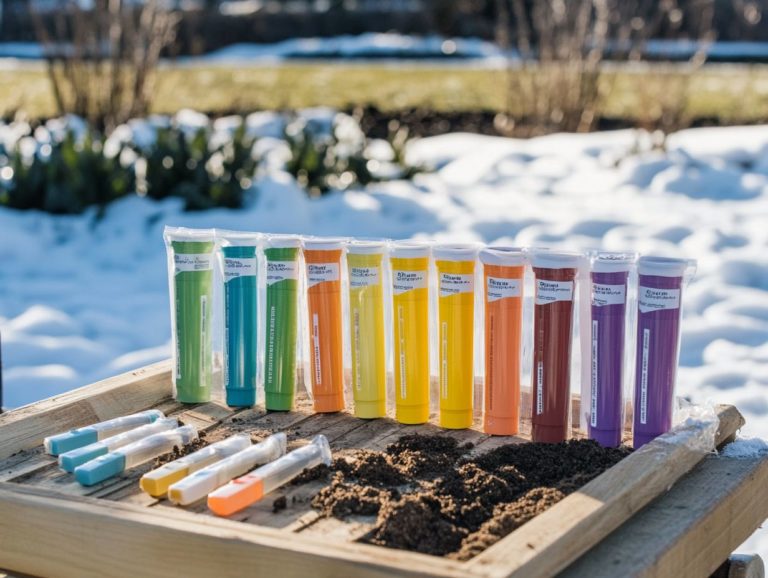Guidelines for Soil Testing in Cold Climates
Soil testing is essential for gardeners and farmers, particularly in cold climates such as West Virginia, where challenges like frost and short growing seasons can significantly impact soil health.
By understanding when and how to test your soil, including various sampling techniques, you can make informed planting decisions that enhance crop yields.
This guide will help you master soil testing, including soil analysis. You ll learn when to collect soil samples, how to interpret the results, and how to choose suitable amendments.
Discover how effective soil management can elevate your gardening experience with enhanced organic matter and improved crop conditions to new heights.
Contents
- Key Takeaways:
- The Importance of Soil Testing in Cold Climates
- When to Test Your Soil
- Types of Soil Tests
- Interpreting Soil Test Results
- How to Collect Soil Samples
- Choosing a Soil Testing Lab
- Using Soil Test Results to Improve Your Garden
- Implementing Recommended Amendments and Fertilizers
- Frequently Asked Questions
- What are the main factors to consider when conducting soil testing in cold climates, particularly in regions like West Virginia?
- When is the best time to conduct soil testing in cold climates?
- What methods should be used for soil testing in cold climates?
- How can I protect the soil samples collected according to standardized sampling techniques during transportation in cold climates?
- Are there any specific guidelines for testing frozen soils, where special attention must be paid to their unique properties, in cold climates?
- What are the consequences of not following proper guidelines for soil testing in cold climates?
Key Takeaways:
- Regular soil testing is vital for thriving gardens in cold climates.
- Spring and fall are the best times to check your soil for accurate results.
- Understanding your soil test results will help you apply the right nutrients to boost your garden’s health.
The Importance of Soil Testing in Cold Climates
Soil testing is essential in cold climates such as West Virginia, where distinctive environmental conditions can profoundly influence soil properties and agricultural practices. For more information on this topic, check out how to test soil nutrients in cold climates, which is particularly useful for managing grapevines or pastures.
A detailed soil test equips you with the knowledge of nutrient status, including the levels of potassium, phosphorus, and calcium. This enables precise fertilizer application that enhances crop conditions and bolsters soil health.
By collecting soil samples, you can take informed steps to foster healthy growth and maximize yields, particularly amid the challenges posed by cold weather. For more detailed guidance, consider identifying soil types in cold climates, as ensuring adequate organic matter and nutrient levels is key.
Understanding local soil types allows you to tailor management strategies effectively, enhancing organic matter and optimizing pH levels. You can also grasp the role of micronutrients in different plants.
Understanding the Unique Challenges
Cold climates pose distinct challenges for soil properties, significantly influencing agricultural practices and crop growth in regions like West Virginia. Local soil types are shaped by both temperature and moisture levels, impacting the health of hayfields and vegetable gardens.
You’ll encounter issues such as frost heaving, which disrupts soil structure and can damage root systems. Nutrient leaching is another concern, occurring more readily in colder, wetter conditions. For more insights, consider understanding soil drainage needs in cold climates, as this ultimately weakens soil health and diminishes crop yields.
Research from West Virginia University highlights the importance of understanding soil nutrients. It shows that microbial activity often declines during harsh winters, impacting the nutrient cycling that is crucial for robust plant growth.
This research highlights the necessity for flexible farming methods designed to tackle these challenges, ensuring that sustainable farming practices, such as proper crop rotation, can thrive even amid increasingly unpredictable weather patterns.
When to Test Your Soil
Knowing when to test your soil can make all the difference for your garden. Ensuring that your fertilizer application, including a micronutrient package, is precisely tailored to meet the unique needs of your plants is crucial. These needs can fluctuate considerably with seasonal shifts and varying soil types.
Best Times for Accurate Results
The optimal times for soil testing to obtain accurate results are generally in the fall and spring. These seasons allow you to assess nutrient status for various crops, including pastures and hayfields, both before and after key growing periods. To improve your soil quality, consider learning how to build healthy soil in cold climates.
During these transitional times, the soil reflects changing environmental conditions that directly influence nutrient availability. In spring, as temperatures rise and microbial activity increases, essential nutrients like nitrogen, phosphorus, and potassium become accessible for new plant growth. Fall sampling provides valuable insights into nutrient reserves and prepares the soil for winter conditions.
By recognizing these dynamic states, you can make well-informed decisions about lawn maintenance and crop rotation, ensuring optimal health and productivity. Accurate soil tests refine your fertilizer formulations and contribute to sustainable soil health strategies. This promotes long-term fertility and resilience in your agricultural and gardening endeavors.
Types of Soil Tests

Conducting various types of soil tests is essential for grasping the intricacies of soil properties and nutrient dynamics. These tests include both chemical analyses tests that measure the chemicals in your soil and physical assessments. This understanding is vital for optimizing fertilizer application and enhancing crop management strategies.
Chemical and Physical Tests
Chemical tests assess soil health by evaluating parameters such as pH levels, nutrient status, and the presence of essential elements including calcium, magnesium, and other micronutrients essential nutrients that plants need in small amounts. Physical tests examine soil texture and structure, offering insights that can significantly enhance your agricultural practices.
Understanding these assessments is crucial for unlocking the secrets of your soil! They shed light on how nutrients interact with plants and microorganisms. For instance, pH levels can dictate nutrient availability. The nutrient status reveals the current supply of essential elements like nitrogen, phosphorus, and potassium.
Examining soil texture provides valuable information about drainage capabilities and aeration, both essential for robust root systems. By properly interpreting these results, you can craft effective fertilization strategies and irrigation techniques. This ultimately leads to improved soil health and maximizes crop yields through customized management practices designed for various crops.
Interpreting Soil Test Results
Interpreting soil test results is crucial for making informed decisions about soil management. These results offer essential insights into pH levels, organic matter content, and the amendments needed to ensure optimal crop growth by understanding the current nutrient status.
By understanding these factors, you can enhance your soil’s health and productivity. This ultimately leads to a more successful agricultural endeavor.
Understanding the Numbers and Recommendations
Understanding the numbers from your soil test results is essential for determining the right nutrient recommendations that will enhance your soil health and promote vigorous plant growth. This is particularly important when analyzing levels of key micronutrients.
These results offer critical insights into nutrient levels, pH, and organic matter elements vital for establishing a balanced soil environment. For example, if your pH level is too acidic or too alkaline, it can impede nutrient absorption. Optimal organic matter levels can significantly improve water retention and microbial activity, enhancing overall soil health.
By interpreting these specific values, you can identify any deficiencies or excesses in nutrients. This gives you the power to make informed decisions about fertilization and soil amendments. Tailored recommendations based on these soil test results not only optimize your crop yield but also contribute to the long-term sustainability of your agricultural practices and improve overall soil health.
Take the first step towards healthier soil today by testing your soil!
How to Collect Soil Samples
Collecting soil samples with precision is crucial for achieving accurate soil testing and analysis. Taking the time to collect soil samples carefully can make all the difference. This process ensures that the results truly represent the nutrient status and properties of your fields or garden. It allows you to make informed decisions for optimal growth and health, especially in vegetable gardens.
Proper Techniques for Accurate Results

Using proper techniques for collecting soil samples is essential. This ensures that the results from soil testing laboratories are both accurate and reliable, guiding you in effective fertilizer application and soil management practices.
To achieve optimal results, consider various factors, including soil depth, sampling locations, and the timing of collection. Aim to sample in the fall or spring when the soil is accessible and not overly saturated or frozen. By taking samples from multiple locations within a field, you’ll capture the variability in soil properties. This is crucial for developing a comprehensive understanding of soil fertility in cold climates and nutrient availability.
Maintaining a consistent methodology whether you choose a grid or zone sampling technique will ensure that your results are not skewed. This leads to better-informed decisions regarding soil amendments and management practices.
Choosing a Soil Testing Lab
Selecting a reputable soil testing laboratory is essential for acquiring reliable analysis results. These results will guide your agricultural practices, including managing nutrients and soil amendments. This choice can significantly influence the effectiveness of your strategies, enhancing your outcomes in the field.
Factors to Consider
When selecting a soil testing laboratory, it’s essential to consider several key factors. Look for certification, service quality, and the range of analysis results offered, including tests for micronutrient packages. This ensures a thorough evaluation of your soil.
These elements can significantly influence the quality of information you receive. Local options like WVU Extension and LSU AgCenter provide specialized services tailored to regional soil characteristics, leading to more accurate recommendations for your specific needs.
The responsiveness and quality of customer service at testing laboratories are important. This can make a difference in communicating your specific testing needs.
By choosing a reputable laboratory, you can obtain insights that are not only precise but also practical, empowering you to make informed decisions for effective soil management.
Using Soil Test Results to Improve Your Garden
By effectively utilizing soil test results, you empower yourself to make informed decisions regarding recommended amendments and fertilizer applications tailored to specific soil types and nutrient needs. This approach can significantly enhance crop conditions by considering organic matter levels and soil properties. It elevates overall soil health, allowing your garden to thrive like never before.
Start testing your soil today to unleash the full potential of your garden!
Implementing Recommended Amendments and Fertilizers
Implementing recommended amendments and fertilizers based on soil test results is crucial for enhancing soil health and maximizing crop yield in your gardens and agricultural fields!
By meticulously analyzing soil nutrient levels, including potassium, phosphorus, calcium, and magnesium, and pH, you can customize your application strategies to precisely meet the needs of your crops. Applying amendments during the off-season improves nutrient absorption when planting begins.
You can choose methods such as broadcasting, often recommended for larger areas like pastures and hayfields, or banding methods, which can be particularly effective for crops such as grapevines and vegetables. This depends on the type of crop and its growth stage. For instance, slower-release fertilizers work wonders for perennials and their unique nutrient requirements, especially regarding small nutrients, while quick-acting options are ideal for annuals, which may benefit from a more robust small nutrient package.
Understanding the characteristics of your soil whether it s sandy, clayey, or loamy is essential for determining the right fertilizer type and ensuring your plants receive the necessary nutrients efficiently.
Frequently Asked Questions

What are the main factors to consider when conducting soil testing in cold climates, particularly in regions like West Virginia?
The main factors to consider are temperature, moisture content, and freeze-thaw cycles. Understanding soil pH in cold climates can greatly affect the properties of the soil and the accuracy of test results.
When is the best time to conduct soil testing in cold climates?
The best time to conduct soil testing is during the spring or fall when the ground is not frozen and the temperatures are more stable. For those interested in gardening, understanding the importance of soil testing in cold-climate gardening is crucial. Avoid testing during extreme cold or hot periods.
What methods should be used for soil testing in cold climates?
Methods like on-site testing and using technology to check soil can enhance soil analysis results. Laboratory testing, especially at local agricultural office resources, can help farmers interpret their soil analysis results. Each method has its advantages and limitations, and a combination may be necessary for accurate results.
How can I protect the soil samples collected according to standardized sampling techniques during transportation in cold climates?
To protect the samples, they should be packed in insulated containers or temperature-controlled vehicles. It is also recommended to keep the samples away from direct sunlight and extreme temperatures during transportation.
Are there any specific guidelines for testing frozen soils, where special attention must be paid to their unique properties, in cold climates?
Yes, frozen soils require specialized equipment and techniques for testing. To achieve accurate results, it is important to follow guidelines and protocols specifically designed for frozen soil testing, such as those outlined in the best soil testing labs for cold climates.
What are the consequences of not following proper guidelines for soil testing in cold climates?
Not following proper guidelines can lead to inaccurate test results, which can result in incorrect assessments and decisions. This can have serious consequences, especially in industries such as construction and agriculture where soil properties play a crucial role.






